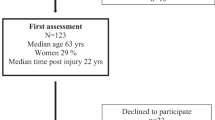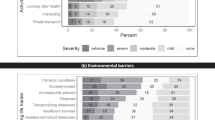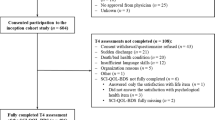Abstract
Study design:
Systematic review.
Objectives:
To identify changes in subjective quality of life (QoL) as one ages with a spinal cord injury (SCI).
Setting:
Vancouver, Canada.
Methods:
Electronic databases were searched for studies reporting on age-related QoL changes over time. Data from relevant studies were transcribed into data extraction forms and analyzed by years post injury (YPI) and chronologic age. Each study was assigned a level of evidence based on a modified Sackett scale.
Results:
In all, 21 studies, each with a low level of evidence, were included for review. The results indicated that regardless of chronologic age, individuals with relatively new SCI have the potential to improve their QoL. Among individuals with advanced YPI, overall QoL is consistently reported as good or excellent over time, however, with variations in different QoL domains.
Conclusion:
The QoL of individuals aging with a SCI has the potential to improve, and remain high and stable over time. As the identified studies provide low levels of evidence, more longitudinal research with greater methodological and measurement rigor is needed to corroborate the findings and conclusions of this review.
Similar content being viewed by others

Log in or create a free account to read this content
Gain free access to this article, as well as selected content from this journal and more on nature.com
or
References
Samsa GP, Patrick CH, Feussner JR . Long-term survival of veterans with traumatic spinal cord injury. Arch Neurol 1993 50: 909–914.
Hitzig SL, Eng JJ, Miller WC, Sakakibara BM . An evidence-based review of aging of the body systems following spinal cord injury. Spinal Cord 49: 684–701.
Gerhart KA, Bergstron E, Charlifue SW, Menter RR, Whiteneck GG . Long-term spinal cord injury: functional changes over time. Arch Phys Med Rehabil 1993 74: 1030.
Charlifue S, Jha A, Lammertse D . Aging with spinal cord injury. Phys Med Rehabil Clin N Am 2010 21: 383–402.
National Spinal Cord Injury Statistical Centre Spinal Cord Injury Facts and Figures at a Glance. NSCISC: Birmingham: Alabama. 2011.
Whalley Hammell K . Exploring quality of life following high spinal cord injury: a review and critique. Spinal Cord 2004 42: 491–502.
Whiteneck GG . Outcome evaluation and spinal cord injury. Neurorehabilitation 1992 2: 31–41.
Dijkers MP . Quality of life of individuals with spinal cord injury: a review of conceptualization, measurement, and research findings. J Rehabil Res Dev 2005 42: 87–100.
Eisenberg MG, Saltz CC . Quality of life among aging spinal cord injured persons: long term rehabilitation outcomes. Paraplegia 1991 29: 514–520.
Kemp BJ, Krause JS . Depression and life satisfaction among people ageing with post-polio and spinal cord injury. Disabil Rehabil 1999 21: 241–249.
Barker RN, Kendall MD, Amsters DI, Pershouse KJ, Haines TP, Kuipers P . The relationship between quality of life and disability across the lifespan for people with spinal cord injury. Spinal Cord 2009 47: 149–155.
Fuhrer MJ, Rintala DH, Hart KA, Clearman R, Young ME . Relationship of life satisfaction to impairment, disability and handicap among persons with spinal cord injury living in the community. Arch Phys Med Rehabil 1992 73: 552–557.
Dijkers M . Correlates of life satisfaction among persons with spinal cord injury. Arch Phys Med Rehabil 1999 80: 867–876.
Putzke JD, Richards JS, Hicken BL, DeVivo MJ . Predictors of life satisfaction: a spinal cord injury cohort study. Arch Phys Med Rehabil 2002 83: 555–561.
Clayton KS, Chubon RA . Factors associated with the quality of life of long-term spinal cord injured persons. Arch Phys Med Rehabil 1994 75: 633–638.
Post M, Van Dijk A, Van Asbeck F, Schrijvers A . Life satisfactionof spinal cord injured compared to a population group. Scand J Rehab Med 1998 30: 23–30.
Krause JS, Crewe NM . Chronologic age, time since injury, and time of measurement: effect on adjustment after spinal cord injury. Arch Phys Med Rehabil 1991 72: 91–100.
Eng JJ, Teasell RW, Miller WC, Wolfe DL, Townson AF, Hsieh JTC et aleditors.. Spinal Cord Injury Rehabilitation Evidence, version 3.0. Vancouver: BC. 2010. http://www.scireproject.com.
Whalley Hammell K . Quality of life after spinal cord injury: a meta-synthesis of qualitative findings. Spinal Cord 2007 45: 124–139.
Diener E, Emmons RA, Larsen RJ, Griffin S . The satisfaction with life scale. J Pers Assess 1985 49: 71–75.
May LA, Warren S . Measuring quality of life of persons with spinal cord injury: substantive and structural validation. Qual Life Res 2001 10: 503–515.
Putzke JD, Richards JS, Hicken BL, DeVivo MJ . Interference due to pain following spinal cord injury: important predictors and impact on quality of life. Pain 2002 100: 231–242.
Mortenson WB, Noreau L, Miller WC . The relationship between and predictors of quality of life after spinal cord injury at 3 and 15 months post discharge. Spinal Cord 2010 48: 73–79.
Krause JS, Coker JL . Aging after spinal cord injury: a 30-year longitudinal study. J Spinal Cord Med 2006 29: 371–376.
Stensman R . Adjustment to traumatic spinal cord injury. A longitudinal study of self-reported quality of life. Paraplegia 1994 32: 416–422.
Kalpakjian CZ, Houlihan B, Meade MA, Darana-Zebari D, Heinemann AW, Dijkers MP et al Marital status, marital transitions, well-being, and spinal cord injury: an examination of the effects of sex and time. Arch Phys Med Rehabil 2011 92: 433–440.
Chen Y, Anderson CJ, Vogel LC, Chlan KM, Betz RR, McDonald CM . Change in life satisfaction of adults with pediatric-onset spinal cord injury. Arch Phys Med Rehabil 2008 89: 2285–2292.
Charlifue SW, Gerhart KA, Whiteneck GG . Conceptualizing and quantifying functional change: an examination of aging with spinal cord injury. Top Geriatr Rehabil 1998 13: 35–48.
Savic G, Charlifue S, Glass C, Soni BM, Gerhart KA, Jamous MA . British ageing with SCI study: changes in physical and psychological outcomes over time. Top Spinal Cord Inj Rehabil 2010 15: 41–53.
Bushnik T . Access to equipment, participation, and quality of life in aging individuals with high tetraplegia. Top Spinal Cord Inj Rehabil 2002 7: 17–27.
Bushnik T, Charlifue S . Longitudinal study of individuals with high tetraplegia (C1-C4) 14 to 24 years postinjury. Top Spinal Cord Inj Rehabil 2005 10: 79–93.
DeVivo MJ, Chen Y . Trends in new injuries, prevalent cases, and aging with spinal cord injury. Arch Phys Med Rehabil 2011 92: 332–338.
van Koppenhagen CF, Post MW, van der Woude LH, de Groot S, de Witte LP, van Asbeck FW et al Recovery of life satisfaction in persons with spinal cord injury during inpatient rehabilitation. Am J Phys Med Rehabil 2009 88: 887–895.
van Leeuwen CM, Post MW, Hoekstra T, van der Woude LH, de Groot S, Snoek GJ et al Trajectories in the course of life satisfaction after spinal cord injury: identification and predictors. Arch Phys Med Rehabil 2011 92: 207–213.
Krause JS, Broderick L . A 25-years longitudinal study of the natural course of aging after spinal cord injury. Spinal Cord 2005 43: 349–356.
Krause JS . Changes in adjustment after spinal cord injury: a 20-year longitudinal study. Rehabil Psychol 1998 43: 41–55.
Crewe NM, Krause JS . An eleven-year follow-up of adjustment to spinal cord injury. Rehabil Psychol 1990 35: 205–210.
Krause JS . Longitudinal changes in adjustment after spinal cord injury: a 15-year study. Arch Phys Med Rehabil 1992 73: 564–568.
Krause JS . Adjustment after spinal cord injury: a 9-year longitudinal study. Arch Phys Med Rehabil 1997 78: 651–657.
Charlifue SW, Weitzenkamp DA, Whiteneck GG . Longitudinal outcomes in spinal cord injury: aging, secondary conditions, and well-being. Arch Phys Med Rehabil 1999 80: 1429–1434.
Krause JS, Saladin LK, Adkins RH . Disparities in subjective well-being, participation, and health after spinal cord injury: a 6-year longitudinal study. NeuroRehabilitation 2009 24: 47–56.
Charlifue S, Gerhart K . Changing psychosocial morbidity in people aging with spinal cord injury. NeuroRehabilitation 2004 19: 15–23.
Sprangers MAG, Schwartz CE . Integrating response shift into health-related quality of life research: a theoretical model. Soc Sci Med 1999 48: 1507–1515.
Craig A, Tran Y, Middleton J . Psychological morbidity and spinal cord injury: a systematic review. Spinal Cord 2009 47: 108–114.
Horley J, Lavery JJ . Subjective well-being and age. Soc Indic Res 1995 34: 275–282.
Kunzmann U, Little TD, Smith J . Is age-related stability of subjective well-being a paradox? Cross-sectional and longitudinal evidence from the Berlin Aging Study. Psychol Aging 2000 15: 511–526.
Baltes PB . Theoretical propositions of life-span developmental psychology: on the dynamics between growth and decline. Dev Psychol 1987 23: 611–626.
Call V, Sprecher S, Schwartz P . The incidence and frequency of marital sex in a national sample. J Marriage Fam 1995 57: 639–652.
DeLamater J, Hyde JS, Fong MC . Sexual satisfaction in the seventh decade of life. J Sex Marital Ther 2008 34: 439–454.
Molten IR, Jensen MP . Aging and disability: biopsychosocial perspectives. Phys Med Rehabil Clin N Am 2010 21: 253–265.
Schwartz CE, Andresen EM, Nosek MA, Krahn GL the RRTC Expert Panel on Health Status Management Response shift theory: important implications for measuring quality of life in people with disability. Arch Phys Med Rehabil 2007 88: 529–536.
Acknowledgements
This study was sponsored by the Rick Hansen Institute and the Ontario Neurotrauma Foundation. We are grateful for salary/scholarship support from the Canadian Institutes of Health Research to BMS (Doctoral Canada Graduate Scholarship), JJE (CIHR MSH-63617), and WCM (CIHR MSH-76731), the Canadian Association of Gerontology Donald Menzies Bursary to BMS, the Michael Smith Foundation for Health Research to JJE and the Toronto Rehabilitation Institute to SLH, which receives funding under the Provincial Rehabilitation Research Program from the Ministry of Health and Long-Term Care in Ontario. The views expressed do not necessarily reflect those of the Ministry.
Author information
Authors and Affiliations
Consortia
Corresponding author
Ethics declarations
Competing interests
The authors declare no conflict of interest.
Rights and permissions
About this article
Cite this article
Sakakibara, B., Hitzig, S., Miller, W. et al. An evidence-based review on the influence of aging with a spinal cord injury on subjective quality of life. Spinal Cord 50, 570–578 (2012). https://doi.org/10.1038/sc.2012.19
Received:
Revised:
Accepted:
Published:
Issue date:
DOI: https://doi.org/10.1038/sc.2012.19
Keywords
This article is cited by
-
Endocrinological and inflammatory markers in individuals with spinal cord injury: A systematic review and meta-analysis
Reviews in Endocrine and Metabolic Disorders (2022)
-
Changes in health-related quality of life among older adults aging with long-term spinal cord injury
Spinal Cord (2021)
-
Participation restriction and assistance needs in people with spinal cord injuries of more than 40 year duration
Spinal Cord Series and Cases (2018)


